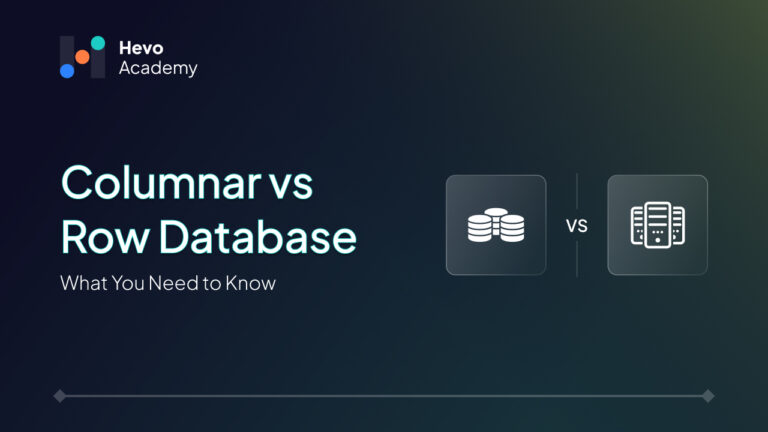Databases don’t just store data; they define how fast your business can think. With modern applications processing billions of records per day, the architecture powering your data system, columnar vs row database, can make or break performance at scale.
Table of Contents
As the generation of global data is set to exceed 181 zettabytes by 2025 (IDC), engineering teams are presented with a critical architectural decision: prefer transactional speed with row-oriented storage, or optimize for analytical throughput with columnar models?
This blog dissects the foundational difference between columnar vs row database, evaluates their effect on query latency, compression efficiency, and CPU usage, and equips you with actual-world scenarios in industries, allowing you to architect without compromise.
What Are Row-Oriented Databases?
Row-oriented databases store data record-by-record, meaning all column values of a single row are stored continuously on disk. This architecture is in perfect synchronization with OLTP (Online Transaction Processing) systems, where the frequent row-level inserts, updates, and deletes are needed. Every disk I/O fetch gets full records, which makes the row stores ideal for workloads such as banking transactions, CRM operations, and inventory systems whose access patterns usually traverse whole rows.

For instance, a single SQL query such as SELECT * FROM customers WHERE id = 123 takes advantage of this layout as the complete record is retrieved without extensive disk seeks.
Indexing schemes like B-tree indexes and primary keys improve performance for point lookups and join-intensive operations. Well-known relational databases such as MySQL, PostgreSQL, and Oracle DB utilize row-based storage engines, for example, InnoDB.
This row-centric design favors data consistency and integrity, which is critical in transactional systems requiring ACID compliance.
What Are Column-Oriented Databases?
Column-oriented databases store data field-by-field, meaning values from the same column are stored sequentially on disk. This architecture is best suited for OLAP (Online Analytical Processing) type of workloads, which frequently traverse large datasets scanning only very few columns, such as aggregating revenue or filtering the region.

Internally, column stores use compressed columnar blocks, enabling faster I/O and improved CPU cache efficiency. Advanced compression algorithms (including the run-length encoding algorithm and the dictionary encoding algorithm) minimize the footprints in the storage. Some of the common ones are Snowflake, Amazon Redshift, Google BigQuery, and file types such as Apache Parquet.
Columnar architecture excels at vectorized execution, predicate pushdown, and parallelized scans, offering substantial performance advantages when performing aggregations, filtering, and joins across massive datasets.
Columnar vs Row Database Storage: Key Differences
Row-based or column-based databases are based on the workload profile. The table below reflects fundamental architectural and performance differences to help you with making your decisions.
| Feature | Row-Based Databases | Column-Based Databases |
| Storage Format | Data stored as complete rows | Data stored as individual columns |
| Optimized For | OLTP – frequent reads/writes of full records | OLAP – heavy aggregation, filtering, reporting |
| Write Performance | High inserts/updates are fast | Slower due to column segmentation |
| Read Performance | Fast for full-row retrieval | Fast for column-specific queries |
| Compression Efficiency | Low – varied data types per row | Highly similar data types in columns |
| Indexing Needs | Often requires extensive indexing | May use fewer indexes due to the structure |
| Scalability | Moderate – row locks and I/O constraints | Excellent – parallelism across columns |
| Data Access Pattern | Reads the entire row, even for one field | Reads only queried columns |
| Schema Flexibility | Less flexible for schema evolution | More tolerant of adding/removing columns |
| Common Use Cases | CRMs, financial systems, mobile/web apps | Data lakes, BI tools, analytics pipelines |
| Examples | MySQL, PostgreSQL, Oracle DB | Snowflake, Amazon Redshift, BigQuery, ClickHouse |
Deep Dive: Performance Considerations
Query Execution Patterns
In row-oriented databases, queries that require frequent INSERT, UPDATE, or full-record retrieval benefit from sequential row storage. This is ideal for OLTP systems where transactional integrity is critical. However, columnar systems perform well for big analytical queries (like SELECT with filters or aggregations).
I/O and Disk Performance
Row-based databases are best in operations that retrieve complete records, hence suitable for transactional systems. Columnar databases, on the other hand, only read the queried fields, thereby saving on disk I/O for analytical queries.
CPU and Memory Efficiency
Row stores can benefit from low-latency writes and efficient row-level access. Column stores provide better compression and memory utilization by placing similar data types in a column, and thereby speeding up the read-oriented workloads with the help of in-memory processing and vectorized execution.
Use Cases & Suitability by Industry
The decision between row-oriented and column-oriented databases usually relies on the characteristics of the workload and the industry-specific requirements, with transactional vs. analytical characteristics of the workload.
Finance
Transactional systems like high-frequency trading platforms or real-time payments demand row-based databases due to the need for rapid INSERT and UPDATE operations. On the other hand, storage in columnar form is beneficial for risk analytics dashboards and fraud detection systems, for which querying of large datasets to get fast aggregation and slicing is required.
Healthcare
Electronic Medical Records (EMRs) are highly transactional, requiring row-oriented systems to manage patient-centric data. At the same time, population-level analytics, applied in clinical research or public health surveillance, benefit from the columnar stores that allow bulk querying and statistical reporting.
E-commerce
Order management, inventory updates, and checkout methods are optimally performed on row-based DBs for real-time consistency. However, in columnar environments, the user behaviour analytics, the recommendation engines, and the A/B testing workloads show better performance.
Startups & Hybrid Models
Many startups employ a hybrid database strategy, blending Postgres or MySQL (row) with Redshift or BigQuery (column) to balance product functionality with analytical insight, achieving agility without sacrificing performance.
Storage & Compression: A Technical Comparison
Database performance and cost optimization require effective storage and compression. Comparison of row-based and columnar databases is as follows.
Compression Efficiency
| Feature | Row-Oriented Storage | Column-Oriented Storage |
| Data Uniformity | Mixed types per row | Homogeneous types per column |
| Compression Methods | Basic (e.g., LZ, GZIP) | Advanced (RLE, Delta, Dictionary encoding) |
| Compression Ratio | Moderate | High (up to 90% in BigQuery/Snowflake) |
| Storage Optimization | Limited | Excellent for repeated or sparse values |
Impact on Cost and Performance
- Cloud Efficiency: Columnar storage reduces cloud storage and I/O costs by compressing similar values across large datasets.
- Query Speed: Smaller compressed blocks improve scan speeds for large analytical queries.
- Row-Based Flexibility: While being less compressible, row stores such as PostgreSQL with JSONB manage various and semi-structured data more flexibly.
File Format and Tools
- Columnar: Apache Parquet, ORC (used in Snowflake, Redshift).
- Row-Based: PostgreSQL, MySQL, Oracle (with JSON, BLOB support).
Winners columnar for analytical performance and cost; row-oriented stays essential for transaction-intensive use cases.
Columnar + Row-Based Hybrids: Do They Exist?
Hybrid databases combine the strengths of row and columnar storage:
- ClickHouse: Primarily columnar, optimized for fast inserts and real-time analytics.
- MariaDB ColumnStore: Adds columnar processing to traditional row-based MariaDB.
- DuckDB: In-process OLAP engine with columnar storage; excellent for local analytics on structured data.
- Apache Druid: It uses columnar storage with real-time ingestion and is ideal for time-series and event-driven analytics.
These engines are suitable for workloads that require:
- Low-latency ingestion (OLTP-like)
- Fast aggregations and scans (OLAP)
- Mixed-use cases like embedded dashboards or streaming analytics
Use hybrids when transactional speed and analytical depth must coexist.
How to Choose: Column vs Row
Whether to employ columnar or row-based storage depends on the workload profile, performance goal, and pattern of data access. Key Considerations are as follows:
- Read vs. Write Intensity
- Use row-based for frequent inserts, updates, and low-latency transactions.
- Choose columnar for heavy reads and large-scale aggregations.
- Query Patterns
- OLTP (transactional queries) → Row
- OLAP (reporting, BI, ML) → Columnar
- Scalability & Cost
- Columnar scales better for large datasets and reduces cloud storage costs through compression.
- Data Modeling Needs
- Row is flexible for normalized schemas and varied data types.
- Columnar excels in denormalized, wide-table analytics.
Conclusion
Understanding the differences between row-oriented and column-oriented databases is essential for designing scalable, efficient data systems. While row-based storage excels at transactional operations, columnar architectures deliver superior performance for analytics and reporting. Each data model offers distinct advantages based on query types, scalability, and storage optimization. As data volumes and complexity grow, selecting the right storage engine based on workload, not hype, is critical. Regardless of whether you are trying to create real-time applications or BI platforms, the best way to ensure long-term success in a data-driven world is by aligning your database architecture with your performance needs.
Frequently Asked Questions
1. Is Snowflake row-based or columnar?
Snowflake is a fully columnar database developed for analytics. It keeps data in a compressed columnar format to enable high-performance querying and scaling large datasets.
2. Can you use both columnar and row databases together?
Hybrid architectures usually integrate a row-based OLTP system and columnar OLAP engines via ETL pipelines for transactional efficiency and analytical depth.
3. Which is better for real-time analytics?
Real-time analytics are best served on columnar databases for their fast scan rates, although computer performance depends on the rate of ingestion and the system architecture.
4. Are NoSQL databases columnar or row-based?
NoSQL databases mainly operate on a document or key-value basis. Others include column-family stores such as Apache Cassandra or HBase, which differ from the true columnar databases such as Redshift or BigQuery.






